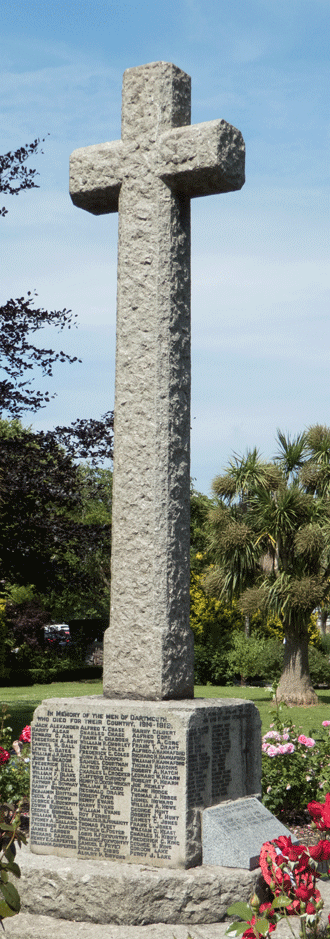John Samuel Webber
Family
John Samuel Webber was the youngest son of Charles Webber and his wife, Sarah Ball Jarvis. Charles was born in Harberton and Sarah in Salcombe; they married in Plymouth in 1880 and moved to Dartmouth around 1883. At that time, Charles worked as a stone-mason.
John was born in 1891 and baptised on 16th March 1893 at St Saviours. Charles at that time worked as a coal lumper, but by the time of the 1901 Census, when the family were living in Lower Street, he was once again working as a mason. John's eldest brother, Sydney, had left home to join the Navy, but several of his brothers and sisters were still at home - Mary, Thirza, William, Florence, and Olive. His eldest sister Eliza married in Plymouth later that year.
The 1911 Census recorded Charles and Sarah Webber living next door to their daughter Mary and her husband Patrick Hanlon, in Foss Street. However, the younger members of the Webber family, including John, presumed still to be living at home or nearby, seem to have escaped the Census enumerators. William had joined the Devonshire Regiment just before the Census (see the story of William Charles Webber, posted to the 2nd Battalion).
According to information published in the Dartmouth Chronicle at the time of John's death, "... He worked at Noss for many years, and afterwards went to Messrs Phillips establishment. He was a prominent footballer and boxer". The newspaper did not, of course, say - in the tragic circumstances of his parents' bereavement - that John was no stranger to its columns before the war, appearing at Dartmouth Police Court on a number of occasions on charges of being drunk and disorderly. In a case brought during December 1913, he was described as a " "striker" in a blacksmith's shop at a shipbuilding yard". The striker's job was to swing a large sledgehammer in heavy forging operations - clearly very physically demanding work.
Things became a little more serious in July 1914, only a few weeks before the start of the war, when a friend of John's, Edwin Arthur Pym, was found drowned in the harbour, following "thirteen drinks" at "various licensed houses", according to evidence given by John at the coroner's inquest. Several newspapers quoted the coroner's remarks that "it was rather a lamentable thing that in [Dartmouth] young men should go from public-house to public-house during an evening, as deceased had done, although he supposed it happened in other places".
Service
John's service papers have not survived, but his name is listed in the Dartmouth Chronicle in their very first list of "Dartmouth patriots who have responded to the National Call to Arms during the present great European War", published on 11th September 1914. Along with a large group of men who came forward at a recruiting meeting held in Dartmouth on 3rd September 1914, John joined the 8th Battalion of the Devonshire Regiment, the first of the "Kitchener" or Service Battalions to be formed by the Regiment. Also in the group was Frederick Widdicombe, also killed in action during the Battle of Broodseinde (though by that time, no longer in the 8th Devons). John, however, remained with the 8th Devons throughout his war service, along with his friend, Frank Pound, who joined the 8th Devons alongside him; they were numbered 10790 and 10791 respectively.
Because of the large numbers of Dartmouth men joining them, both early in the war and later, the 8th Devons' experiences may be followed through a succession of the stories we have published so far:
- from formation to early September 1915: Andrew Prettyjohn
- the Battle of Loos, 25th September 1915 in which eight Dartmouth men died
- from Loos to early February 1916: George Burnell
- the Battle of the Somme, to September 1916: William Marks Carpenter and Charles Chase
- from late September 1916 to March 1917: Harry Bowhay
- from April to June 1917: Bertie James Coles
John survived the Battle of Loos and the Battle of the Somme, but was wounded some time in October 1916, whilst the 8th Devons were in the line near Armentieres. In an article of 3rd November 1916 marking the death of his elder brother William, the Dartmouth Chronicle reported:
Mr and Mrs Webber have two other sons serving - one with another battalion of the Devons in France, and another on HMS Tiger. The same post which brought the sad news of the death of Private W C Webber brought also a letter containing the information that Mr and Mrs Webber's youngest son had been wounded in the back and head by shell fire, but we are glad to hear that he is now better and has been able to return to the trenches again.
It would seem that this injury must have been relatively slight because John was, apparently, back with his unit before his name appeared as "wounded" in the published casualty lists (10th November 1916).
We pick up the 8th Devons story after their time holding the front line at Bullecourt in June and July 1917. They came out of the line on 8th August 1917 and went into training at Bailleulval. On 29th August 1917, together with the 9th Devons, they were moved up to Flanders, where the Third Battle of Ypres had started nearly a month earlier. Throughout September, however, they remained well to the rear, continuing to train and absorb drafts of reinforcements, until brought forward on 29th September, to take part in the renewed offensive.
The Third Battle of Ypres
The Third Battle of Ypres had begun on 31st July 1917 - for the background to this offensive, see the story of William John Farrow Bates, of the 2nd Devons, killed on the first day while attacking east of the city.
On 25th August, General Haig transferred responsibility for planning the next stage of the offensive to General Plumer, commanding Second Army, from General Gough, commanding Fifth Army. General Plumer first wanted three weeks preparation, before a series of "bite and hold" attacks, in four steps, each followed by a six-day pause, to allow for consolidation, defence against any counter-attack, and preparation of the next step.
The first step, now called the Battle of Menin Road, had begun on 20th September, in good weather, and - broadly - achieved its objectives. After the requisite six days, the next step, now called the Battle of Polygon Wood, was launched on 26th September. Although an attack by the Germans intended to disrupt preparations had some success, the front was pushed forward another 1000-1250 yards. In the third step on 4th October, the Second Army (now including the 8th and 9th Devons) attacked the Broodseinde Ridge, the Zonnebeke Spur and Gravenstafel Spur, whilst the Fifth Army alongside them to the north moved on Poelcappelle.
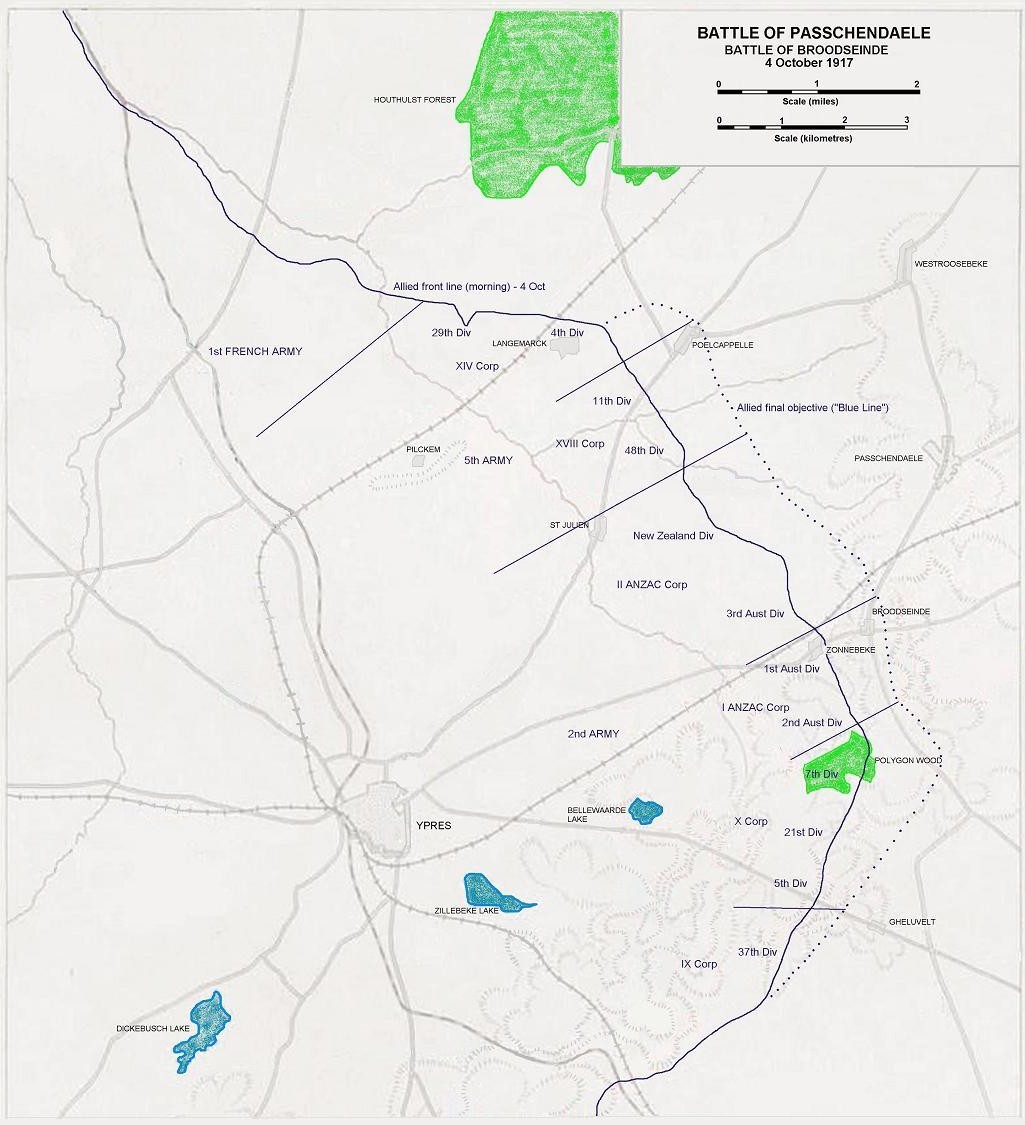
Battle of Broodseinde
The Seventh Division was to the right of the attacking front overall, with its starting line on the Eastern edge of Polygon Wood, so-called because of its shape (though by this stage, little was left of the wood as such). The direction of their attack was north-eastward, towards high ground east of the road between Broodseinde and Beselare, in the vicinity of Noordenhoek (now part of Beselare) and the village of Molenaarelst. The 8th Devons were on the left of the Division's front, next to the 2nd Australian Division. They were to begin the attack in their sector, with their objective called the "Red Line"; the Borders and the Gordons were then to go through to take the second objective, the "Blue Line". The 9th Devons were in reserve.

According to the report of the action in the Battalion War Diary:
the actual dispositions of the enemy were not known. It had been ascertained from aeroplane photographs that he was holding the high ground opposite the Divisional front by means of a system of concrete pill boxes and small posts ... he was reported to be holding his line lightly in front and more strongly in rear ... As events proved, the enemy had also planned an attack for 6am on the morning of 4th [October] and consequently many more troops were present than might have been expected.
The 8th Devons' move up to the front on 2nd October was, according to the Regimental History:
... a most unpleasant experience ... After passing Hooge [crater] it was ... a question of sticking to the corduroy or duckboard tracks, or sticking in the pools of mud and water which otherwise monopolised the scene ... The whole place was an ocean of mud, in which every other feature seemed to have been obliterated except the pillboxes and the Butte in Polygon Wood ... As the Battalion neared the Butte it had to go right through a German barrage which there was no avoiding. Luckily, the mud did at least minimise the effect of the shells, and the 8th reached their positions with about 25 casualties.
There were further casualties the following day as the rations were brought up.
When they lined up for the attack, "A" and "C" Companies were in front, with "B" behind and "D" in reserve. The Borders and Gordons were about 200 yards further back. Shortly before "zero-hour" at 6am, an enemy barrage came down between "D" Company and the Borders and Gordons, so "D" Company moved forward.
At 6am the barrage began, moving forward 100 yards every four minutes, and then as it approached the "Red Line", 100 yards in six minutes. On the right, "A" company met an enemy pill-box whose garrison also manned a dug-out behind, covered by a machine-gun. However, "a Lewis gun engaged and neutralised the machine-gun, while bombers rushed and took the position". An enemy grenade-thrower was taken a little further on, with 20 prisoners; and a large concrete dugout discovered which was the enemy aid Post, with a German Medical Officer and "a fair number" of wounded Germans. After twenty minutes, "A" Company had reached the "Red Line".
On the left, "C" Company also met little resistance. The Battalion War Diary's report recorded that "the enemy showed no desire to contest the ground, and was only too ready to come out of his pill boxes and put his hand up". Though there were enemy snipers just inside the protective barrage who "caused trouble", "C" Company also reached the "Red Line" in twenty minutes.
At this stage there were still considerable German forces in isolated strong-points. "B" Company, following closely behind both leading companies, overcame one of these close to the pill-box met by "A" company. However, according to the War Diary's report, "The majority of the men found were simply sitting outside their pill boxes, shell holes and dugouts waiting to be taken prisoners". "B" company took about 30 prisoners. "D" Company, following up, dealt with two more pill-boxes. The report attributed the lack of resistance to the effect of the British barrage and machine-gun fire supporting the attack, which had caused very heavy casualties amongst troops forming up for the German attack.
Overall, the 8th Devons' attack was (in the opinion of the Regimental History) "a brilliant success ... the British barrage had been excellent and the first line had kept right up to it and had lost very few men". Most of the casualties had been sustained in "D" Company, under the enemy barrage, before the attack began. At 8.10am the Borders and Gordons came through, and were equally successful in reaching the "Blue Line".
The next challenge was to consolidate and hold the positions reached. Enemy shell fire, guided by spotter aeroplanes, increased in intensity during the day. The rain was ceaseless, and as soon as trenches were a couple of feet deep, they filled with water. Lewis guns and rifles became clogged with mud thrown up by the shelling and the digging, and casualties mounted. The 8th Devons remained in their positions (shifting slightly to try to avoid the worst of the enemy barrages) until they were relieved by the 9th about midnight on 7th/8th October. By this time, their losses were heavy (figures are those in the Regimental History - the figures in the Battalion War Diary differ slightly):
- six officers and 57 men killed
- eleven men missing
- eight officers and 198 men wounded
Totalling 280 all ranks, this was nearly half those who had gone into action - but mostly sustained before and after the attack itself.
The experiences of the 1st Devons further to the right and south at Polderhoek are described in the story of Edwin Burnell. Overall the attack of 4th October 1917 was successful, the two Anzac Corps in the centre meeting all their objectives. The "bite and hold" tactics continued.
Death
According to all surviving records, John was killed in action on 7th October 1917, while the 8th Devons held the position they had gained three days before.
Two other Dartmouth men, Thomas Rendle and Frederick Worden were killed in action on the day of the attack, 4th October 1917.
On 26th October 1917, the Dartmouth Chronicle carried the news of John's death. The news arrived at the same time as that of another double bereavement, that of the Hearn family (Leonard Hearn was killed on 18th October 1917), and also at the same time as the death of Frederick Widdicombe. News of yet further bereavements were to come, in what was called "Dartmouth's Terrible Week", with a treble bereavement in the Burnell family (see the story of Edwin Burnell, referred to above). The newspaper commented:
During the past week the sad side of war has been brought home to us as it never has before. Several Dartmothians have laid down their lives, and in two instances families have sustained double bereavements, losing two sons each within the last fifteen months. These are terrible days, and the sympathy of everyone in the town will go out to the bereaved ones, although language will fail in the adequate expression of it.
John's death was also reported separately:
Private John Samuel Webber
Another very sad double bereavement equally distressing is sustained by Mr and Mrs Webber, Newcomen Cottages, Drake's Passage, in the death of their youngest son Private John Samuel Webber, who made the supreme sacrifice on October 7th, at the age of 25. The sad news came in a letter from his chum, Frank Pound, who in expressing his deep sympathy with Mr and Mrs Webber, writes that their son was killed instantaneously, and therefore suffered no pain.
"We buried him" he says "the same as you would at home, and we put a small cross on his grave. All his mates have told me to send their sympathy to you, as he was such a good fellow. He was always smiling, and was liked by all the regiment".
Another letter of sympathy from an ex-sergeant of the Devons, now at home in England, describes Private John Samuel Webber as a soldier and a man, and says no-one could help liking him. He worked at Noss for many years, and afterwards went to Messrs Phillips establishment. He was a prominent footballer and boxer. His mother and father will have the sincerest sympathy of everyone in this their cruel second loss.
Frank Pound had joined up with John at the start of the war. He survived to return to Dartmouth and died in 1950. Sadly, the grave to which he referred in his letter - and to which his sisters referred in the tributes below - must subsequently have been destroyed, or perhaps lost its identification, for John is commemorated on the Tyne Cot Memorial to the Missing, see below.
John Webber died a couple of weeks short of the first anniversary of the death of his elder brother William, a sad coincidence noted in the family's announcements appearing in the Chronicle on 26th October and 2nd November 1917:
Webber - In loving memory of my dear son Private John Samuel Webber, of the ---- Devons, who was killed in action October 7th 1917. Also my dear son Private William Charles Webber, of ---- Devons, who died of wounds in France 18th October 1916. Sadly missed by their sorrowing mother, father, and only brother Syd on HMS Tiger.
William's eldest brother Sidney Ball Webber had joined HMS Tiger on 3rd October 1914. She was his last ship and he served in her throughout the war, including, presumably, the Battle of Jutland, in which she fought. He survived the war and was demobilised on 17th March 1919.
John's sisters, Mary, Thirza, Florrie, and Olive, also placed tributes to their brothers. Only a couple of months earlier, Olive had received final confirmation that her husband, Thomas Charles, had been killed on the first day of the Battle of the Somme in 1916.
Webber - October 7th, killed in action, Private John Samuel Webber, of the ---- Devons. Sadly missed by his loving sister Mary Hanlon. Loved by all who knew him.
Webber - October 7th, killed in action. Private John Samuel Webber, of the ---- Devons. Also in ever loving memory of my dear brother Private William Charles Webber, of the ---- Devons, who died of wounds in France October 18th 1916. Sadly missed by their loving sisters Thirza, Florrie, Olive.
Webber - October 7th, killed in action, Pte John Samuel Webber, of the Devons. Also in ever loving memory of my dear brother Pte William Charles Webber of the Devons, who died of wounds in France, October 18th 1916. Sadly missed by his loving sister Eliza, residing at Milford Haven - Loved by all.
Commemoration
As one of 35,000 men of British and New Zealand forces who died on the Ypres front between August 1917 and November 1918, John is commemorated on the Tyne Cot Memorial Wall to the Missing, which surrounds the Tyne Cot Cemetery. Tyne Cot was originally a barn, around which were several fortified "pill boxes"; it was captured by the 3rd Australian Division on 4th October 1917, during the Battle of Broodseinde. After the war, most surviving pill-boxes were dynamited by specialist contractors, and the material used to improve local road surfaces. However, the pill-boxes near Tyne Cot Cemetery were not destroyed, to prevent damage to graves, and were subsequently incorporated into the design of the Memorial. John is thus commemorated quite close to where he died.
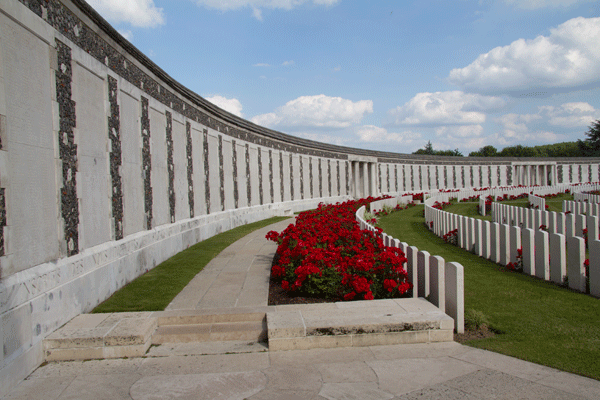
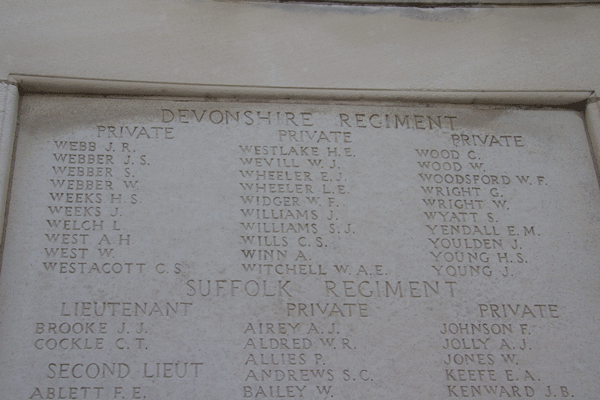
In Dartmouth, John is commemorated with his brother William on the Town War Memorial (probably in error, he was not included with his brother on the St Saviour's Memorial Board).
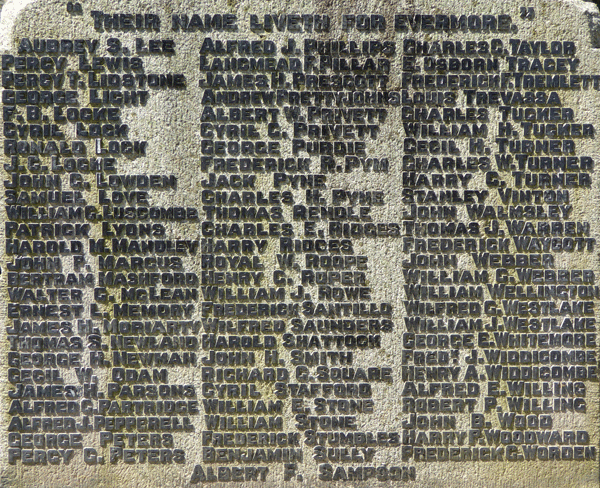
Sources
War Diary of the 8th Battalion Devonshire Regiment, July 1915-November 1917, available at the National Archives, fee payable for download, reference WO 95/1655/2
The Devonshire Regiment 1914-1918, compiled by C T Atkinson, publ 1926, London and Exeter
Information Held on Database
| Surname: | Webber |
| Forenames: | John Samuel |
| Rank: | Private |
| Service Number: | 10770 |
| Military Unit: | 8th Bn Devonshire Regiment |
| Date of Death: | 07 Oct 1917 |
| Age at Death: | 25 |
| Cause of Death: | Killed in action |
| Action Resulting in Death: | Third Battle of Ypres |
| Place of Death: | Beselare, Belgium |
| Place of Burial: | Commemorated Tyne Cot Memorial, Belgium |
| Born or Lived in Dartmouth? | Yes |
| On Dartmouth War Memorial? | Yes |
| On St Saviour's Memorials? | No |
| On St Petrox Memorials? | No |
| On Flavel Church Memorials? | No |
| In Longcross Cemetery? | No |
| In St Clement's Churchyard? | No |
| On a Private Memorial? | No |
| On Another Memorial? | No |















